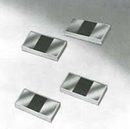This is a thermal conductivity gas sensor that uses a highly sensitive thin-film thermistor, and detects gas concentration by detecting differences in the thermal conductivity of the tested gas.
Thermal conductivity gas sensors exhibit output changes when the thermal conductivity of the ambient atmosphere differs from that of air. The output signal shows excellent linearity with respect to the concentration of the measured gas, for example, carbon dioxide can be measured from 0.5% to 20%.
Thermal conductivity sensors using thermistors are temperature- and humidity-dependent, so the actual circuit design must take these characteristics into account when making temperature and humidity corrections.





